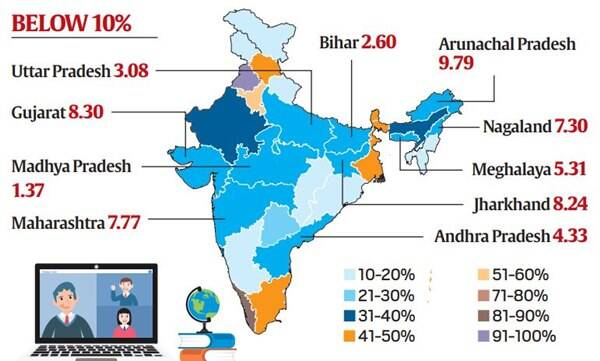Social Justice
Digital Gap in Education
- 03 Aug 2022
- 6 min read
For Prelims: Digital Gap, Information and Communication Technology, Right to Education, Article 21A
For Mains: Digital gap in Education, Its Impact and Way Forward
Why in News?
Recently, the Ministry of Education informed Lok Sabha that less than 10% of schools are equipped with Information and Communication Technology (ICT) tools or Digital Tools, in at least 10 states of India.
What are the ICT Tools?
- ICT tools for teaching and learning cover everything from digital infrastructures such as printers, computers, laptops, tablets, etc., to software tools such as Google Meet, Google Spreadsheets, etc.
- It refers to all communication technologies that are the tools to access, retrieve, store, transmit and modify information digitally.
- ICTs are also used to refer to the convergence of media technology such as audio-visual and telephone networks with computer networks, by means of a unified system of cabling (including signal distribution and management) or link system.
- However, there is no universally accepted definition of ICTs considering that the concepts, methods, and tools involved in ICTs are steadily evolving on an almost daily basis.
What is a Digital Gap?
- About:
- It is a gap between demographics and regions having access to modern information and communications technology (ICT) and those not having access.
- It exists between developed and developing countries, urban and rural populations, young and educated versus older and less-educated individuals, and men and women.
- In India the urban-rural divide is the single biggest factor in the Digital Gap.
- Status:
- A study in 2021 by the Azim Premji Foundation showed that almost 60 % of school children in India cannot access online learning opportunities.
- A study by Oxfam India found that even among students of urban private schools, half of the parents reported issues with Internet signal and speed. A third struggled with the cost of mobile data.
- Impact:
- Causes Dropouts and Child Labour:
- Children belonging to the Disadvantaged Groups may suffer the consequence of not having to fully pursue their education or worse still drop out because of the lack of access to ICT.
- They even run the danger of being drawn into child labour or worse, child trafficking.
- Deprivation of Quality Education:
- It will deprive people of higher/quality education and skill training that could help them contribute to the economy and become leaders on a global level.
- Unfair Competitive Edge:
- The poor will remain void of crucial information presented online concerning academia, and thus they will always lag, and this may be summed up by poor performance.
- Hence superior students who can access the internet have an unfair competitive edge over their less privileged counterparts.
- Learning Disparity:
- The people in lower socio-economic classes are disadvantaged and have to undergo long hours of cumbersome studies in meeting the objectives of the course.
- While the rich can easily access schooling materials online and work on their programs in a flash.
- Causes Dropouts and Child Labour:
What are the Constitutional Provisions for Right to Education?
- Originally Part IV of Indian Constitution, Article 45 and Article 39 (f) of DPSP (Directive Principles of State Policy), had a provision for state funded as well as equitable and accessible education.
- The 86th Constitutional Amendment in 2002, provided Right to Education as a fundamental right in Part-III of the Constitution.
- It inserted Article 21A which made Right to Education a fundamental right for children between 6-14 years.
- It provided for a follow-up legislation Right to Education Act 2009.
What are the Related Initiatives?
Way Forward
- Governments can become powerful instruments in bridging the digital divide by ensuring affordable, easy-to-use technologies. The high cost of internet connectivity, the price of technological devices, electricity tariffs, and taxes are major contributors to the digital Gap for both teachers and students.
- Teachers and students need to be fully trained on how to effectively use what the internet and modern technologies have to offer. The less students can use these tools, the more the digital divide widens.
- Educational online content creators should aim to make information available in as many languages as possible. When the users are confident that they can see content in their native or local languages, they are more inclined to use similar tools that provide personalised benefits.
- There is a special need to reduce the gender digital divide. Barriers and constraints in accessing the internet impede women's and girls' full involvement in the social and economic progress of their communities and countries.





